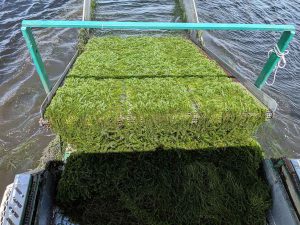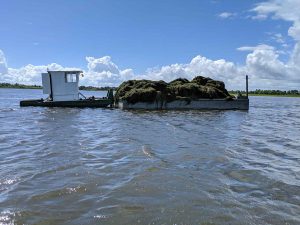By: Dr. James Leary, UF/IFAS Center for Aquatic and Invasive Plants Faculty
Florida’s lakes are shallow, warm and highly productive ecosystems. The nutrient-rich waters support an abundance of plants and wildlife. The plants living in these freshwater systems come in many forms, from emergent cattail, to floating hyacinth, and completely submerged hydrilla. Though plants are essential to a healthy lake, invasive plants grow almost year-round. This excessive growth, over time, falls to the lake bottom and contributes to nutrient-rich muck build up. A muck layer can be problematic since it creates low oxygen conditions that can really change which plants will grow and which critters will colonize the area. One solution to this problem is to mechanically harvest the plants and remove them before they have a chance to form muck.

Mechanical harvesters are a century-old technology still used today for cutting and collecting aquatic vegetation and sediment debris impounding a water body. Picture a combine harvester that gathers crops in the front and stores grain in the rear. Now picture that combine as a 90-foot-long boat operating on open water, harvesting plants as much as 10 feet below the surface. The concept is amazing, and many see it as the solution for improving Florida’s lakes since it clearly removes plants and nutrients from the lake without any herbicide inputs. However, all management techniques, as in life, have pros and cons.

A mechanical harvester’s greatest virtue is the capability to remove this biomass or plant matter from a lake in order to reduce muck build up and nutrient enrichment of a water body. Over the last decade, mechanical harvesting has been utilized by the Florida Fish and Wildlife Conservation Commission (FWC) to manage over 2,700 acres with half of the tasks directed to removal of floating islands. These benefits make harvesters a very important lake management tool.

However, mechanical harvesters are not perfect. When operating, they cannot differentiate between desirable plants and invasive plants, they harvest them all. Sometimes, even fish can be harvested if the plants are really dense. Additionally, mechanical harvesters are also considered less efficient and more cost-prohibitive when compared to other management options. Harvesters typically cover one to two acres per hour and cost of operations has historically been three to four times higher than a herbicide treatment. However, the numbers usually quoted to describe the efficiency of harvesting is generally from small machines used in small research studies. Therefore, it is important to review these numbers by getting large harvesters to operate at scale on a large lake.
Next week’s blog will describe harvest efficiency when 300 acres are being managed across several weeks. This description will show how current mechanical harvesting technology may fare in the real world.
Dr. James Leary, UF/IFAS CAIP faculty member, wrote this piece. Any questions should be directed to Shelby Oesterreicher at soesterreicher@ufl.edu. For more information about the UF/IFAS Center for Aquatic and Invasive Plants, please visit http://plants.ifas.ufl.edu. Be sure to follow us on social @UFIFASCAIP.
UF/IFAS CAIP, Turning Science Into Solutions.
 0
0
